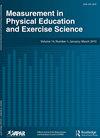Testing Measurement Invariance in Physical Education and Exercise Science: A Tutorial Using the Well-Being Self-Efficacy Scale
IF 1.9
4区 教育学
Q2 EDUCATION & EDUCATIONAL RESEARCH
Measurement in Physical Education and Exercise Science
Pub Date : 2021-08-17
DOI:10.1080/1091367X.2021.1964508
引用次数: 8
Abstract
ABSTRACT In physical education and exercise science, it is common to examine mean differences between groups or to assess change across time. However, before group differences or change can be confidently examined, measurement invariance can be tested. Measurement invariance tests the equivalence of a construct across groups or across time. If measurement invariance is supported, then differences in latent means can more confidently be attributed to individuals’ different standings on a construct. Though an important first step to confidently examine group differences and change across time, this technique is sometimes not used in the field. Thus, the purpose of this manuscript was to provide a didactic review and illustration of measurement invariance within the field. We review a methodological approach to measurement invariance, the sequential steps used in this approach, assessing model-data fit, and testing partial invariance. We provide an illustration of the technique and conclude with practical considerations.体育与运动科学的测试测量不变性:一个使用幸福自我效能量表的教程
在体育教育和运动科学中,研究群体之间的平均差异或评估随时间的变化是很常见的。然而,在可以自信地检查群体差异或变化之前,可以测试测量不变性。度量不变性测试跨组或跨时间的构造的等价性。如果支持测量不变性,那么潜在均值的差异可以更有信心地归因于个体在一个构式上的不同立场。虽然这是自信地检查群体差异和随时间变化的重要的第一步,但这种技术有时不会在该领域使用。因此,这份手稿的目的是提供一个说教性的审查和说明测量不变性的领域。我们回顾了测量不变性的方法学方法,该方法中使用的顺序步骤,评估模型数据拟合和测试部分不变性。我们提供了该技术的一个例子,并总结了实际考虑。
本文章由计算机程序翻译,如有差异,请以英文原文为准。
求助全文
约1分钟内获得全文
求助全文
来源期刊

Measurement in Physical Education and Exercise Science
Medicine-Orthopedics and Sports Medicine
CiteScore
4.20
自引率
33.30%
发文量
24
期刊介绍:
The scope of Measurement in Physical Education and Exercise Science (MPEES) covers original measurement research, special issues, and tutorials within six substantive disciplines of physical education and exercise science. Six of the seven sections of MPEES define the substantive disciplines within the purview of the original research to be published in the journal: Exercise Science, Physical Activity, Physical Education Pedagogy, Psychology, Research Methodology and Statistics, and Sport Management and Administration. The seventh section of MPEES, Tutorial and Teacher’s Toolbox, serves to provide an outlet for review and/or didactic manuscripts to be published in the journal. Special issues provide an avenue for a coherent set of manuscripts (e.g., four to five) to collectively focus in-depth on an important and timely measurement-related issue within the scope of MPEES. The primary aim of MPEES is to publish high-impact manuscripts, most of which will focus on original research, that fit within the scope of the journal.
 求助内容:
求助内容: 应助结果提醒方式:
应助结果提醒方式:


